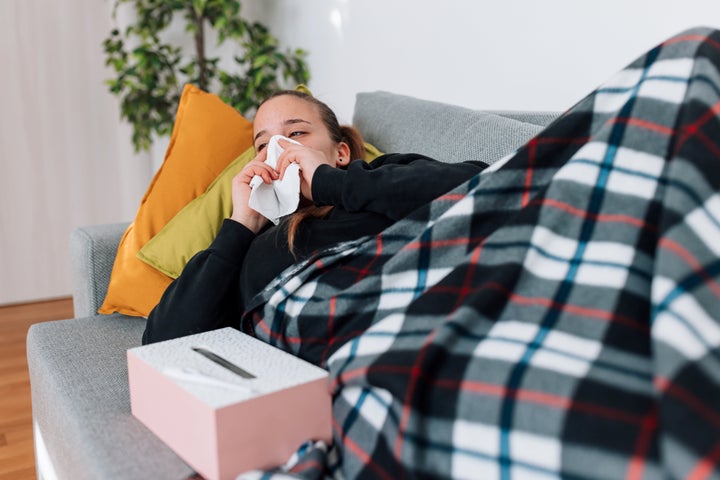
If you’re anything like me, you’ll love nothing more than staying at home (cancelled plans? A dream). But your beloved abode could be making you sick, apparently.
Mould, damp, poor ventilation and even your lighting setup can cause what the NHS calls “sick building syndrome”.
Symptoms can include a runny nose, stuffiness, a sore throat, and even rashes.
Here are seven signs your home might just be causing problems with your health.
You have a constant, not-quite-cold
Everything from mould to poor ventilation to cockroaches (yes, really) can cause cold-like symptoms, according to WebMD.
Mould spores can lead to an itchy throat, a cough, and even a stuffy nose, while everything from dusty carpets to asbestos can make breathing trickier than usual.
And high humidity can create everything from asthma-like symptoms to chronic sinusitis.
It’s especially telling if your perma-sniffle seems to go away about an hour or so after leaving your home, WebMD says.
Your eyes always water after you clean your loo
It can be tempting to use the strongest chemicals you can when cleaning your home. But chemicals in your favourite cleaning products – especially stronger ones, like bleach – can seriously irritate your lungs, eyes and nose.
And bleach can also eat away at grouting over time, allowing mould to permeate and grow in between your tiles.
Of course, you also have to be careful when mixing cleaning products. Combining bleach with acids creates dangerous – sometimes deadly – chlorine gas, so make sure to be as careful and conservative as you can during your weekly deep clean.
That weird rash never seems to go away
There are loads of reasons for rashes to form, but one of them could come from inside your home.
Aside from getting contact dermatitis from cleaners, fabric softeners and more, you could also be suffering from mould rash.
Symptoms include dry, flaky skin, raised bumps, brown or pink patches, and itchiness.
You can’t stop sneezing
Dust can hide basically everywhere in your home – your carpet, your curtains, and even the back of your fridge (did you know it can start blowing dust around your home if you don’t clean it regularly?).
In an American study, up to 90% of dust samples contained toxic chemicals and irritants. On top of that, cockroach droppings, saliva and body parts (hope you’re not eating while reading this) can create allergy-like symptoms.
You’ve gained weight
So we’ve established that dust can make you wheezy, stuffy and even heighten asthma and hay fever. But there’s also data to suggest those malicious mites can lead to weight gain.
A study of mice linked the toxic chemicals found in lots of household dust to the production of triglyceride accumulation (or fat gain).
You feel hazy, moody, or headache-y
Lead paint, carbon monoxide and even gas leaks can cause changes in your behaviour, mood and general feeling of wellbeing. Impulsiveness, haziness, poor memory, migraines and erratic behaviour can all be symptoms.
Your lighting can even be a cause of stress and low mood – the wrong setup can cause everything from eye strain to fatigue, too.
Like with all of these conditions, see a doctor and call the relevant authorities immediately if you suspect a gas leak or lead poisoning.
Your plants aren’t doing well, no matter what you do
We’ve all been guilty of accidental plant murder. But if your leaf babies are dying despite your best plant parenting, it might be a canary in the coal mine-type sign that you have a gas leak.
Gas affects plants even before it can be smelled, so it’s worth investigating the true cause of that constantly-wilting monstera.
So what can I do if I’m suffering from these issues?
It’s important to contact a medical professional if you suspect your home is making you sick, especially if the symptoms are sudden and/or intense.
If you suspect gas leaks or the presence of carbon monoxide, evacuate the building immediately and contact the relevant authorities – and lead paint will also need to be addressed ASAP.
For other issues, dehumidifiers, improved insulation and ventilation can help to limit the amount of mould in your home, while careful vacuuming can limit your dust exposure.
And be sure to use lower-strength cleaning products – I swear by baking soda and vinegar – if you’re struggling to break up with bleach.
Your home should be a place of rest and relaxation, so it’s worth looking into – and fixing – anything that’s stressing out your body ASAP.